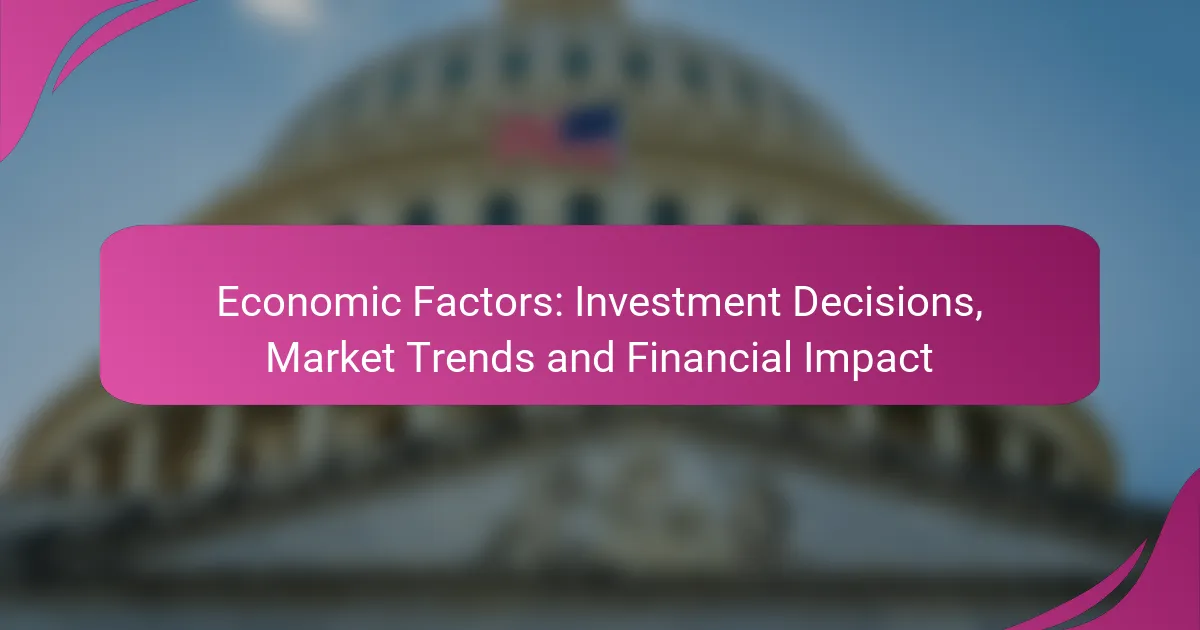Economic factors are essential in guiding investment decisions, as they influence risk assessment, borrowing costs, and purchasing power. Current market trends, including sustainable investing and advancements in technology, further shape where capital is allocated, impacting overall financial outcomes. By analyzing key economic indicators, investors can gain valuable insights into market health and make informed choices that align with their financial objectives.

How Do Economic Factors Influence Investment Decisions?
Economic factors play a crucial role in shaping investment decisions by affecting risk assessment, borrowing costs, purchasing power, and overall market strategies. Investors must consider these elements to make informed choices that align with their financial goals.
Market volatility impacts risk assessment
Market volatility refers to the fluctuations in asset prices and can significantly influence how investors assess risk. High volatility often leads to increased uncertainty, prompting investors to adopt more conservative strategies or diversify their portfolios to mitigate potential losses.
For example, during periods of high volatility, such as economic downturns or geopolitical tensions, investors may shift their focus to more stable assets like bonds or blue-chip stocks. Understanding market volatility helps investors gauge when to enter or exit positions effectively.
Interest rates affect borrowing costs
Interest rates directly impact borrowing costs, influencing both individual and corporate investment decisions. When interest rates are low, borrowing becomes cheaper, encouraging businesses to invest in expansion and consumers to spend more, which can stimulate economic growth.
Conversely, high interest rates can deter borrowing, leading to reduced investment and spending. Investors should monitor central bank policies and interest rate trends to anticipate changes in market conditions and adjust their strategies accordingly.
Inflation influences purchasing power
Inflation affects purchasing power by eroding the value of money over time, which can impact consumer behavior and investment returns. When inflation rates rise, the cost of goods and services increases, potentially leading to decreased consumer spending and lower corporate profits.
Investors should consider inflation when evaluating investment options, as certain assets, like real estate or commodities, may offer better protection against inflation than traditional stocks or bonds. Keeping an eye on inflation trends can help investors make more strategic decisions.
Global economic trends shape investment strategies
Global economic trends, such as trade agreements, emerging markets, and technological advancements, can significantly influence investment strategies. Investors must be aware of these trends to capitalize on opportunities and manage risks effectively.
For instance, a growing economy in a developing country may present lucrative investment opportunities in sectors like technology or infrastructure. Staying informed about global economic indicators can help investors align their portfolios with favorable market conditions and trends.

What Are Current Market Trends Affecting Investments?
Current market trends significantly influence investment decisions, shaping where capital flows and impacting financial outcomes. Key trends include the rise of sustainable investing, growth in the technology sector, a shift towards remote work solutions, and the emergence of cryptocurrencies.
Rise of sustainable investing
Sustainable investing focuses on generating positive social and environmental impacts alongside financial returns. Investors are increasingly prioritizing companies that adhere to environmental, social, and governance (ESG) criteria, reflecting a broader societal shift towards sustainability.
Funds dedicated to sustainable investments have seen substantial growth, often outperforming traditional funds. Investors should consider the long-term benefits of aligning their portfolios with sustainable practices, as this trend is likely to continue gaining traction.
Technology sector growth
The technology sector is experiencing robust growth, driven by advancements in artificial intelligence, cloud computing, and digital transformation. This sector offers significant investment opportunities, particularly for those looking to capitalize on innovative companies that are reshaping industries.
Investors should focus on identifying key players in emerging technologies, as well as established firms adapting to new trends. Diversifying within the tech sector can mitigate risks while maximizing potential returns.
Shift towards remote work solutions
The shift towards remote work solutions has accelerated due to recent global events, leading to increased demand for technology that supports remote collaboration. Companies providing tools for virtual communication, project management, and cybersecurity are seeing heightened interest from investors.
Investors should evaluate businesses that have successfully adapted to this trend, as they are likely to benefit from sustained demand. Consideration of the scalability and innovation of these companies can guide investment decisions in this evolving landscape.
Emergence of cryptocurrencies
Cryptocurrencies have emerged as a new asset class, attracting both retail and institutional investors. The volatility and potential for high returns make them appealing, but they also come with significant risks and regulatory uncertainties.
Investors should approach cryptocurrencies with caution, conducting thorough research and considering their risk tolerance. Diversifying within the crypto space and staying informed about regulatory developments can help navigate this complex market.

How Do Economic Indicators Affect Financial Impact?
Economic indicators play a crucial role in determining the financial impact on investments and market trends. Key indicators such as GDP growth, unemployment rates, and consumer confidence provide insights into economic health and can significantly influence investment decisions.
GDP growth signals economic health
GDP growth is a primary indicator of a country’s economic health, reflecting the overall increase in the value of goods and services produced. A rising GDP typically suggests a robust economy, encouraging investment as businesses anticipate higher consumer demand.
Investors often look for GDP growth rates in the range of 2-4% as a sign of stability. Consistent growth can lead to increased stock market performance, while declining GDP may prompt caution and a reevaluation of investment strategies.
Unemployment rates indicate market stability
Unemployment rates serve as a barometer for market stability, with lower rates generally indicating a healthier economy. When unemployment is low, consumer spending tends to rise, which can positively impact business revenues and stock prices.
Investors should monitor unemployment trends, particularly those below 5%, as they often correlate with economic expansion. Conversely, rising unemployment can signal economic distress, prompting investors to reassess their portfolios and consider defensive strategies.
Consumer confidence affects spending
Consumer confidence is a key indicator of how optimistic consumers feel about the economy, directly influencing their spending habits. Higher consumer confidence typically leads to increased spending, which drives business growth and investment opportunities.
Indicators such as the Consumer Confidence Index (CCI) can provide insights into consumer sentiment. A CCI above 100 is generally seen as positive, suggesting consumers are likely to spend more, while a lower index may indicate caution and reduced spending, impacting market trends negatively.

What Criteria Should Investors Consider?
Investors should evaluate several key criteria when making investment decisions, including risk tolerance, investment horizon, and diversification strategies. These factors help shape a tailored investment approach that aligns with individual financial goals and market conditions.
Risk tolerance assessment
Risk tolerance assessment involves understanding how much risk an investor is willing and able to take on. This can vary widely among individuals, influenced by factors such as age, financial situation, and investment experience.
To gauge risk tolerance, investors can use questionnaires or consult with financial advisors. Generally, those with a higher risk tolerance may opt for volatile assets like stocks, while conservative investors might prefer bonds or stable funds.
Investment horizon determination
Investment horizon determination refers to the length of time an investor expects to hold an investment before needing to access the funds. Short-term horizons (less than three years) often favor lower-risk investments, while long-term horizons (over five years) can accommodate higher-risk options.
Understanding your investment horizon helps in selecting appropriate assets. For example, if you plan to buy a home in a few years, you might choose safer investments to protect your capital, whereas retirement savings can be invested more aggressively.
Diversification strategies
Diversification strategies involve spreading investments across various asset classes to reduce risk. By diversifying, investors can mitigate the impact of poor performance in any single investment, enhancing overall portfolio stability.
Common diversification methods include investing in different sectors, geographic regions, or asset types such as stocks, bonds, and real estate. A well-diversified portfolio might allocate 60% to equities, 30% to fixed income, and 10% to alternative investments, depending on individual risk profiles and goals.

How to Analyze Market Trends for Better Decisions?
To analyze market trends effectively, focus on identifying patterns and shifts that can influence investment decisions. This involves understanding various analytical tools and economic indicators that provide insights into market behavior.
Utilizing technical analysis tools
Technical analysis tools help investors evaluate market trends by analyzing price movements and trading volumes. Common tools include moving averages, relative strength index (RSI), and Bollinger Bands, which can indicate potential buy or sell signals.
For example, a simple moving average can smooth out price data to identify the direction of the trend. Investors often look for crossovers between short-term and long-term averages to make informed decisions.
Interpreting economic reports
Economic reports, such as GDP growth rates, unemployment figures, and inflation data, provide critical insights into market conditions. Understanding these reports can help investors gauge the overall health of the economy and anticipate market movements.
For instance, a rising GDP typically signals economic growth, which may lead to increased consumer spending and investment opportunities. Conversely, high inflation rates could prompt central banks to adjust interest rates, impacting market trends.
Following expert market forecasts
Expert market forecasts offer valuable perspectives on potential future trends based on extensive research and analysis. Analysts often provide insights into sectors expected to perform well or poorly, guiding investment strategies.
Investors should consider a range of forecasts from reputable sources, as these can vary significantly. Keeping an eye on consensus estimates can help in making more informed decisions while avoiding reliance on a single opinion.

What Are the Long-Term Economic Trends to Watch?
Long-term economic trends significantly influence investment decisions, market dynamics, and financial outcomes. Key factors include demographic shifts, technological advancements, and environmental sustainability, all of which shape consumer behavior and business strategies.
Demographic shifts and their impact
Demographic shifts refer to changes in the population’s age, race, and distribution, which can profoundly affect economic trends. For instance, an aging population in many developed countries may lead to increased demand for healthcare services and retirement planning, while younger populations in emerging markets may drive technology adoption and consumer spending.
Investors should consider how these demographic changes can create new markets or alter existing ones. For example, as millennials become the largest consumer group, businesses that cater to their preferences, such as sustainability and digital services, are likely to thrive. Understanding these shifts can help investors identify sectors poised for growth.
Additionally, demographic trends can influence labor markets. A shrinking workforce in some regions may lead to wage inflation, impacting business costs and profitability. Investors should monitor these trends closely to adjust their strategies accordingly and capitalize on emerging opportunities.
